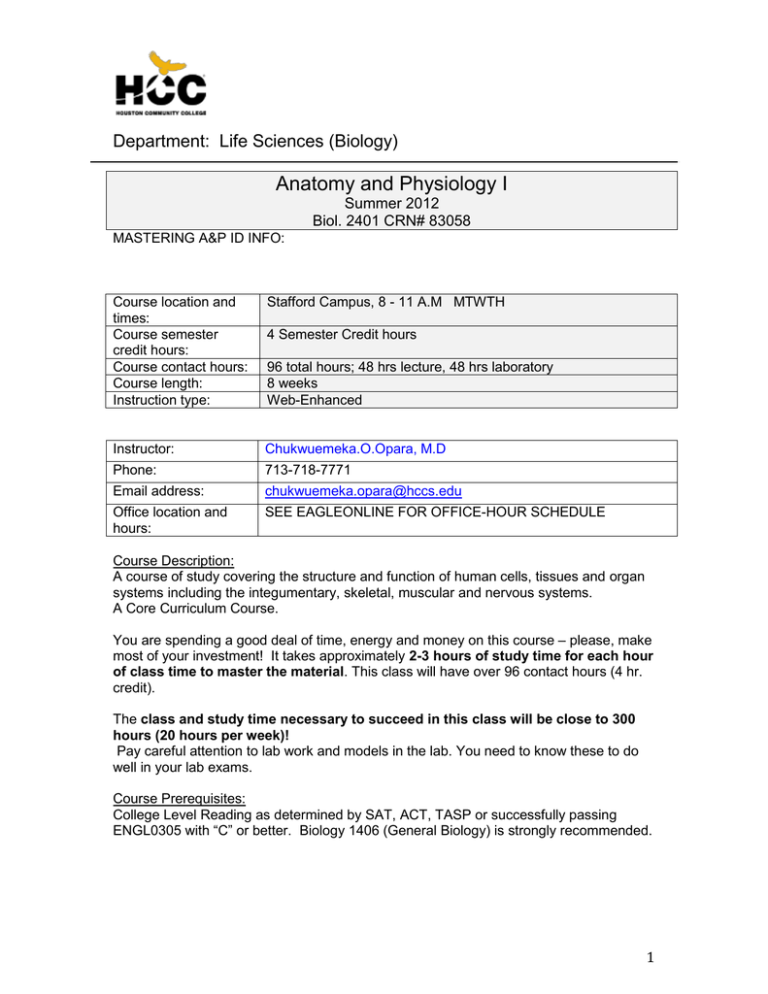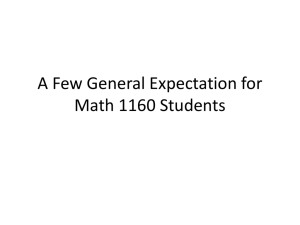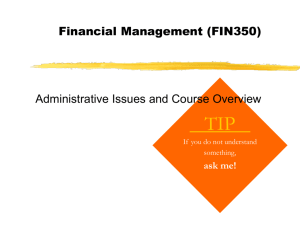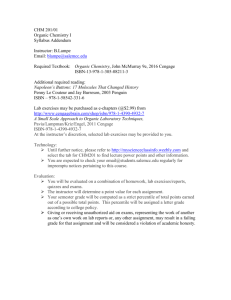Lab Exam #1 - Learning Web
advertisement

Department: Life Sciences (Biology) Anatomy and Physiology I Summer 2012 Biol. 2401 CRN# 83058 MASTERING A&P ID INFO: Course location and times: Course semester credit hours: Course contact hours: Course length: Instruction type: Stafford Campus, 8 - 11 A.M MTWTH Instructor: Chukwuemeka.O.Opara, M.D Phone: 713-718-7771 Email address: chukwuemeka.opara@hccs.edu Office location and hours: SEE EAGLEONLINE FOR OFFICE-HOUR SCHEDULE 4 Semester Credit hours 96 total hours; 48 hrs lecture, 48 hrs laboratory 8 weeks Web-Enhanced Course Description: A course of study covering the structure and function of human cells, tissues and organ systems including the integumentary, skeletal, muscular and nervous systems. A Core Curriculum Course. You are spending a good deal of time, energy and money on this course – please, make most of your investment! It takes approximately 2-3 hours of study time for each hour of class time to master the material. This class will have over 96 contact hours (4 hr. credit). The class and study time necessary to succeed in this class will be close to 300 hours (20 hours per week)! Pay careful attention to lab work and models in the lab. You need to know these to do well in your lab exams. Course Prerequisites: College Level Reading as determined by SAT, ACT, TASP or successfully passing ENGL0305 with “C” or better. Biology 1406 (General Biology) is strongly recommended. 1 Course Goals: This course is intended for students majoring in one of the physical sciences or life sciences, engineering, or for students who are pursuing pre-professional programs in medicine, dentistry, pharmacy, veterinary medicine, or other health programs. The course is also beneficial to students who are preparing themselves for higher-level science courses in their respective curricula. Course Student Learning Outcomes: The course is designed to provide the information and exercises necessary for student to obtain an understanding of the anatomical and physiological processes of the human organism. Topics covered in this course include the molecular, cellular, tissue and organ structures and functions of the integumentary, skeletal, muscular, nervous systems and the special senses. Program Learning Outcomes: Program SLO #1 To recognize, identify, and describe the basic structures and functions associated with most life forms. Program SLO #2 To develop basic laboratory techniques appropriate to the field of Biology. Program SLO #3 To develop study skills and habits appropriate for pre-professional students interested in health-related fields. The following Student Learning Outcomes, with their associated assessment criteria, are not all-inclusive, and are meant to be used along with all other course learning outcomes and assessment devices, listed under Course Objectives, in the determination of the student's final course grade. Completion of the specific Student Learning Outcomes listed below, at any assessment grading level, does NOT and will NOT guarantee the student that final course grade at the end of the semester. Course Student Learning Outcomes: The course is designed to provide the information and exercises necessary for student to obtain an understanding of the anatomical and physiological processes of the human organism. Topics covered in this course include the molecular, cellular, tissue and organ structures and functions of the integumentary, skeletal, muscular, nervous systems and the special senses. 1. Students will be able to understand and apply the principals of homeostasis and the importance of feedback loops. PSLO* #1 2. Students will be able to evaluate information and make conclusions based on their knowledge of membrane transport. PSLO#1 3. Students will be able to apply their knowledge of muscle structure to explain how muscles function. PSLO#1 2 4. Students will be able to apply their knowledge of the structure of the skeletal system to its functions. PSLO#1 5. Students will be able to understand and apply their knowledge of changes in polarity on membrane potential. PSLO#1 6. Students will be able to apply and demonstrate their knowledge concerning reflex arcs PSLO#s 1 and 2 7. Students will be able to apply the knowledge gained in lab utilizing anatomical models, physiological experiments, histological slides and the compound light microscope. PSLO#2 8. Students will utilize online interactive evaluation tools to gauge their understanding of key anatomical and physiological concepts prior to lecture/examinations/quizzes where applicable. PSLO#3 Learning Objectives: 1. Consistently able to demonstrate understanding and application of feedback loops on homeostasis without the instructor’s help. 2. Consistently able to explain membrane transport and determine the outcome of scenarios concerning membrane transport 3. Always able to describe muscle structure and use that knowledge to explain muscle function 4. Always able to apply knowledge of the structure of the skeletal system to its functions. 5. Consistently able to demonstrate knowledge of interactions involving changes in membrane polarity without the instructor’s help. 6. Consistently able to demonstrate all parts, functions, and steps involved in a reflex arc. 7. Consistently prepared and able to demonstrate skills using the body system models and laboratory techniques at the classroom standards. Consistently able to find and focus the specimen on the microscope slide without the instructor’s help. 8. Consistently uses online tools to prepare for class, always ready for classroom discussions and instructor’s Q&A sessions, completes all online quizzes prior to due date. 3 Course Calendar: Week 1 Lecture Schedule Introduction to Anatomy and Physiology I by Dept. Chairman General Biology Proficiency Exam Ch. 1 An introduction to Anatomy and Physiology Ch. 2 The chemical level of organization* Mastering A and P for Chapter 1, Chapter 2 2 Lab Schedule Laboratory Safety Rules Regulations Microscope Anatomic Terminology Ch. 3 The cellular level of organization* Ch. 4 Tissue level of organization Mastering A and P for Chapters 3 and 4 Tissues Ch. 5 Integumentary System Integumentary system Human skeletal system Exam #1 – Ch 1-5 Ch. 6 Osseous tissue and bone structure Mastering A and P for Chapters 5 and 6 3 4 5 Ch. 7 The axial skeleton Human Skeletal system Ch. 7 The axial skeleton Mastering A and P for Chapter 7 Human Skeletal system Ch. 8 The appendicular skeleton Human Skeletal system Ch. 8 The appendicular skeleton Ch. 9 Articulations Articulations Mastering A and P for Chapters 8 and 9 Pre-lab exam 1 practice practical Ch. 10 Muscle tissue Lab Exam #1 Ch. 10 Muscle tissue Ch. 11 The muscular system Mastering A and P Quiz for Chapter 10 Human Muscular system Ch. 11 The muscular system Mastering A and P Quiz for Chapter 11 Exam #2 - Ch 6 and 10/11 Human Muscular system Ch. 12 Neural tissue Ch. 13 Spinal Cord and Spinal Nerves, and Spinal Reflexes Mastering A and P for Chapters 12 and 13 Brain and Spinal cord Cranial 4 Ch. 14 The Brain and Cranial Nerves Mastering A and P for Chapter 14 Exam #3 - Ch 12-14 6 Nerves The Autonomic NS Human Reflexes Ch. 15 Neural integration I: sensory pathways and the somatic nervous system Mastering A and P for Chapter 15 Ch. 16 Neural integration II: The autonomic Nervous System and higher-order functions. Pre-lab final practice practical Ch. 17 The special senses Mastering A and P for Chapter 16 7 Ch. 17 The special senses Mastering A and P for Chapter 17 8 Exam #4 - Ch 15-17 Exit Exam Lab Final * These chapters are a review of General Biology Information. Students attempting Biology 2401 should already be well versed in this information. THE INSTRUCTOR RESERVES THE RIGHT TO CHANGE THE CONTENT SCHEDULE BASED ON THE NEEDS WITH ADVANCED NOTICE TO THE CLASS. !!!! Instruction Methods: Pearson’s course software MasteringAandP will be utilized for chapter quizzes. The primary focus of the course will be on instructor lectures including illustrations, animations, and group activities and assigned textbook readings. Lecture material will correspond to the topics covered in the required textbook, but your instructor may include more detail on certain topics. Topics and concepts covered during lecture or included in the assigned reading will be included in exams. !!!!! Laboratory sessions will include exercises from our department online lab manual website or required laboratory manual. Lecture may be included during lab sessions to clarify or detail concepts. Student Assignments: Students are required to read assigned chapters and to complete Chapter and Atlas Quizzes. Additional announced and unannounced quizzes during lecture or lab may be conducted throughout the semester. Student Assessments: Students will be assessed via lecture and laboratory examinations, chapter quizzes, a comprehensive final lecture and lab examinations. Additionally, there is a required General Biology proficiency examination at the beginning of the semester and a Final Exit examination at the end of the semester. 5 Instructional Materials: Textbook: HCCS PACKAGES - Fundamentals of Anatomy & Physiology: Ninth Edition, Martini et al., Benjamin Cummings, New York, NY, 2012. Hardbound - MARTINI ISBN# 1256112291 "BINDER" BOUND - MARTINI ISBN# 1256134317 Lab book: Online lab Manual Web Resources: Blackboard learning system or Eagle online. MasteringAandP (free with purchase of new required textbook; used books will require you to purchase a MasteringAandP account) HCC Policy Statement: ADA HCC Policy Statement: Academic Honesty Any student with a documented disability (e.g. physical, learning, psychiatric, vision, hearing, etc.) who needs to arrange reasonable accommodations must contact the Disability Services Office at the respective college at the beginning of each semester. Instructors are authorized to provide only the accommodations requested by the Disability Support Services Office. If you have any special needs or disabilities that may affect your ability to succeed in college classes or participate in any college programs or activities, please contact the DSS office for assistance. At Southwest College, Contact: Dr. Becky Hauri 5407 Gulfton Houston, Texas 77081 Phone: 713-718-7909 Fax: 713-718-7781 TTY: 713-718-7909 Students are responsible for conducting themselves with honor and integrity in fulfilling course requirements. Disciplinary proceedings may be initiated by the college system against a student accused of scholastic dishonesty. Penalties can include a grade of "0" or "F" on the particular assignment, failure in the course, academic probation, or even dismissal from the college. Scholastic dishonesty includes, but is not limited to, cheating on a test, plagiarism, and collusion. 6 HCC Policy Statement: Student attendance, 3peaters, withdrawal deadline Attendance Students are expected to attend classes regularly. Students are responsible for materials covered during their absences, and it is the student's responsibility to consult with instructors for make-up assignments. Instructors check class attendance daily. A student may be dropped from a course for excessive absences after the student has accumulated absences in excess of 12.5% of the hours of instruction (including lecture and laboratory time). Note that 12.5% is approximately 4 classes or labs for a 4-semester hour course. Habitual tardiness will not be tolerated. Students are expected to be in attendance for the entirety of the scheduled class and are responsible for completing assignments scheduled during their absence/s. It is the student’s responsibility to amend their professional/personal schedule to meet the provided class schedule. Repeaters Students who repeat a course for a third or more times may soon face significant tuition/fee increases at HCC and other Texas public colleges and universities. Please ask your instructor / counselor about opportunities for tutoring / other assistance prior to considering course withdrawal or if you are not receiving passing grades. Withdrawals Withdrawal from the course after the official day of record (see current catalog) will result in a final grade of “W” on the student transcript and no credit will be awarded. It is the student’s responsibility to initiate and complete a request for withdrawal from any course. Students will be required to formally request a drop from their instructors prior to the administrative drop date deadline (SEE HCCS CALENDAR). Abandoning the course or failing to formally drop, will result in a grade being given based on the work completed for the entire course (including missed exams). The State of Texas has begun to impose penalties on students who drop courses excessively. For example, if you repeat the same course more than twice, you have to pay extra tuition. Beginning in fall 2007, the Texas Legislature passed a law limiting first time entering freshmen to no more than SIX total course withdrawals throughout their educational career in obtaining a certificate and/or degree. Receiving a "W" in a course may affect the status of your student Visa. Once a W is given for the course, it will not be changed to an F because of the visa consideration. Please contact the International Student Office at 713-718-8520 if you have any questions about your visa status and other transfer issues 7 Instructor Requirements: Basic Requirements Students should be on time for class and be prepared with required materials including textbook and lab manual. Full class attendance is required including lecture and lab portions. Full attention during lecture and lab is required. Phones/Electronic Devices Absolutely no phone or other personal electronic devices are to be used during class (lecture and lab). This includes making or taking a call, reviewing messages, texting, playing games, checking email, surfing the web, anything that involves a phone or other personal electronic device. If your work or family situation requires that you be available via phone, your phone can be on vibrate mode and you can take the call during our regular scheduled breaks or you can exit the class to review the call. Notify your friends, family, employers, and anyone else who regularly contacts you that you will be in class and that you should be contacted only when necessary. The taking of calls during class is not only disruptive but it is also discourteous to classmates and the instructor. STUDENTS ARE NOT PERMITTED TO HANDLE CALLS DURING EXAMS. Testing Procedures Be sure to arrive early for your examinations. There are time limits for exams. You will not be given extended time for testing if you arrive late. Entering and exiting the lecture room or lab room is not permitted once exams have begun. Please be sure to use bathroom before or after. Deportment Students are expected to conduct themselves as adults. This includes courteous and respectful behavior towards instructor and classmates. Disruptive behavior or any behavior that interferes with any educational activity being performed by the instructor will not be allowed. Additionally, no student may interfere with his/her fellow students’ right to pursue their academic goals to the fullest in an atmosphere appropriate to a community of scholars. Disruptive behavior may result in removal from the class. Lab Policy Lab safety is stated in lab manual. Lab rules and regulations will be discussed during the first lab and will be adhered to at all times. Each student is responsible for cleaning up after labs, this includes glassware, utensils, specimens/models and other material used during lab time (no, clean up is not covered by your lab fees). Program/Discipline Requirements Proficiency Exam Bio 2401 Exit Exam A = 90-100% HCC Grading Scale: B = 80-89% C = 70-79% D = 60-69% F = less than 60% 8 Instructor Grading Criteria: Students must adhere to testing schedule. Failure to take a test (lab or lecture) will result in a “0” for the missed exam. Exceptions include work, family, or personal (health) emergency, and must be properly documented prior to any make-ups. Only one make-up exam per semester is allowed (with proper medical documentation) and must be arranged with instructor ASAP. There is no repeating of examinations or “dropping” of lowest grade/s. Examination Format Lecture exams will include multiple choice questions and essay/short answer questions. Lab exams will include identification, labeling and short answers reviewing anatomical models and specimens. Grade Calculation Lecture Exam 1 100 pts Lecture Exam 2 100 pts Lecture Exam 3 100 pts Lecture Exam 4 100 pts Mastering A&P Activities/Quizzes 100 pts. Critical Thinking questions 100 pts. In-Class Quizzes 100 pts Lab Exam 1 and completed labs 100 pts Lab Exam 2 and completed labs 100 pts Dept. Exit Exam 200 pts. Final Score 1100 pts 9 Scoring Rubric: Objective Learning Method Resources Evaluation 1. Students will be able to understand and apply the principals of homeostasis and the use of feedback loops. PSLO* #1 Reading lab manual Lecture attendance Reading course textbook Interactive digital exercises Case studies Textbook Textbook-related Internet resources Laboratory manual Literature searches Exams- written and oral Class participation exercises Quizzes Open-ended case studies 2. Students will be able to evaluate information and create conclusions based on their knowledge of membrane transport. PSLO#1 3. Students will be able to apply their knowledge of muscle function. PSLO#1 Lecture attendance Reading course textbook Interactive digital exercises Textbook Textbook-related Internet resources Laboratory manual Literature searches Exams- written and oral Class participation exercises Quizzes Open-ended case studies Reading lab manual Lecture attendance Reading course textbook Interactive digital exercises Textbook Textbook-related Internet resources Laboratory manual Literature searches 4. Students will be able to apply their knowledge of skeletal system and its functions. PSLO#1 Reading lab manual Lecture attendance Reading course textbook Interactive digital exercises Exams- written and oral Class participation exercises Quizzes Open-ended case studies Laboratory practical Textbook Exams- written Textbook-related and oral Internet Class resources participation Laboratory exercises manual Quizzes Literature Open-ended case searches studies Laboratory practical 10 Objective 5. Students will be able to understand and apply their knowledge of changes in polarity on membrane potential. PSLO#1 Learning Method Lecture attendance Reading course textbook Interactive digital exercises Resources Textbook Textbookrelated Internet resources Laboratory manual Literature searches Examswritten and oral Class participation exercises Quizzes Open-ended case studies Examswritten and oral Class participation exercises Quizzes Open-ended case studies Laboratory practical Examswritten and oral Class participation exercises Quizzes Open-ended case studies Laboratory practical 6. Students will be able to apply and demonstrate their knowledge concerning reflex arcs PSLO#s 1 and 2 Reading lab manual Lecture attendance Reading course textbook Interactive digital exercises Textbook Textbookrelated Internet resources Laboratory manual Literature searches 7. Students will be able to apply the knowledge gained in lab utilizing anatomical models, physiological experiments, histological slides and the compound light microscope. PSLO#2 Reading lab manual Lecture attendance Reading course textbook Interactive digital exercises Classroom management system Interactive digital exercises Classroom management system Internet Textbook Textbookrelated Internet resources Laboratory manual Literature searches 8. Students will utilize online interactive evaluation tools to gauge their understanding of key anatomical and physiological concepts prior to lecture/examinations/qui zzes where applicable. PSLO#3 *PSLO= Program Student Learning Outcomes Evaluation Textbookrelated Internet resources Pre-class tests Post-class tests Quizzes 11





